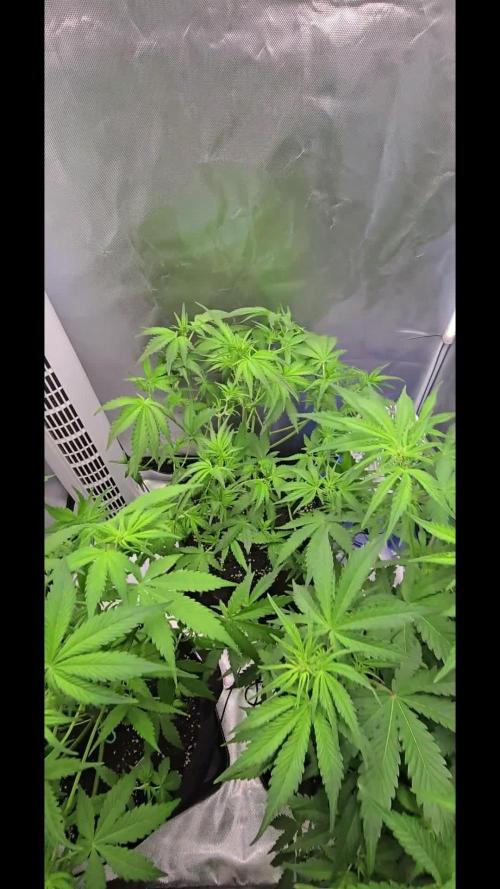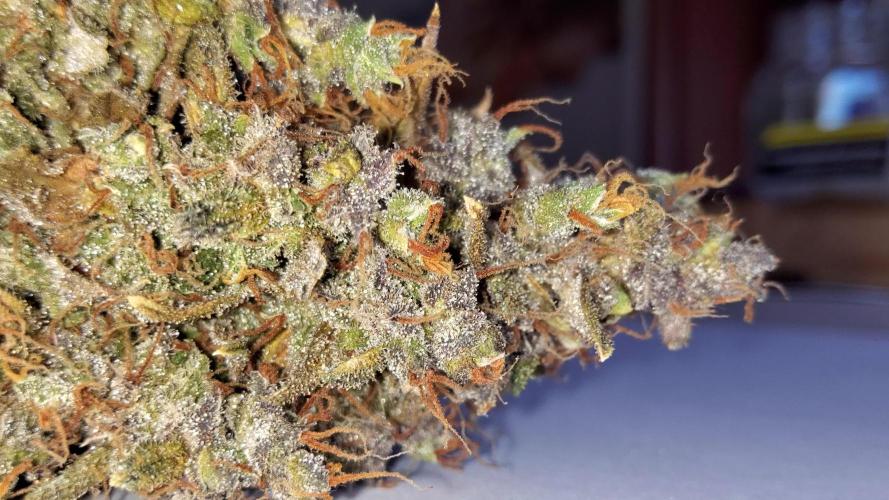The Grow Awards 2026 🏆 





























Likes
6
Share


@Muravushka
Follow
During my previous grow, I harvested and made some bubble hash. Afterward, I dropped the used, wet buds onto this coco, and it seems some seeds sprouted from the leftover material. I’m not even sure if they’re photoperiod or autoflower, but hey—let's roll with it!
Both my pH meter and PPM meter are broken. I have no idea why they keep breaking so often. They’re ADWA meters, and while you can replace the reading elements, the replacements cost half the price of a new meter. It’s frustrating, and I really don’t want to keep buying them every time I start a new grow
Processing
Likes
39
Share


@Randyb4
Follow
Day 113 39 Days of flower, First day of Week 16
Day 115 41 Days of flower
Watered with 4 gallons of spring water with 3 ml/gal of fish shit pH-6.6@68°F, buds are all looking good, all plants have alittle purple in them.
Day 117 43 Days of flower (First day of Week 7)
Day 119 45 Days of flower
Watered with 4 gallons of spring water pH-6.5@70°F. Buds looks better everyday, with less and less white hairs as the days go by. Buds are forming beautifully.
Likes
15
Share


@BastiFarm
Follow
Octava semana de vegetación y esto luce así, hermosas y vigorosas las 2 Kukulkán, porfin pude solucionar la carencia que tenían, estoy regando con niveles de EC muy altos sobre los 2.0 pero si ellas lo asimilan bien entonces le damos no más, estoy regando con 5 ml de fertilizante radicular y 4 ml de algae plus y 3 ml de calmag.
Hoy preparé el suelo donde irán los clones con las micorrizas de elite 91 myco Jordan y tire unas semillas de happy clover, la mayoría de los clones ya están enraizados solo esperaré a que colonicen un poco más el vaso en donde están, estoy muy satisfecho con los resultados hasta ahora, ya que es primera vez que hago esquejes, veremos más adelante cómo evolucionan.
Aún no se cuantas semanas de vegetación les daré a las Kukulkán, todo depende de cómo crezcan y cuanto se demoren en el crecimiento.
EC: 2,3
PH: 6,4
Temperatura agua de riego: 21 grados
Temperatura indoor: 25 grados
Humedad relativa : 50%-85%
Likes
26
Share


@MG2009
Follow
03/21/2021
All going well with the exception of the broken branch, but she is still looking healthy she(cutting) is in vermiculite and soil blend and soaked with Grow Rich 4-10-3 with IBA,to see if she roots. If not at least mother should have better buds with one less top.
1st video is at lights on, 2nd is just before lights out.
Likes
59
Share


@DogDoctorOfficial
Follow
Time to stop the extra P suplement, from now on if she want Phosphorous she can grab what ever still in the soil and from there she can move to her reserves stock on herself, i did increase my K for this final stage , she is moving fast and i want them to have big fruits hehehe
What a Queen this one is, i mean she can take it all and more and still goes , her friend the Runtz also another keeper in the closet, 2 of a kid that i just love and love and love heheh <3 <3 <3
as for the rest just maintaining and observing the changes needs and it all, truly believe them clones finish always before the moms do, so i am aiming for the same with in this round but lets keep seeing and going along hehehe
As always thank you all for stopping by, for the love and for it all , this journey of mine wold just not be the same without you guys, the love and support is very much appreciated and i fell honored and blessed with you all in my life <3<3<3
#aptus #aptusplanttech #aptusgang #aptusfamily #aptustrueplantscience #inbalancewithnature #trueplantscience #dogdoctorofficial #growerslove
With true love comes happiness <3<3<3 Always believe in your self and always do things expecting nothing and with an open heart , be a giver and the universe will give back to you in ways you could not even imagine so <3<3<3
<3 Friendly reminder all you see here is pure research and for educational purposes only <3
<3<3<3 Growers Love To you All <3<3<3
Likes
7
Share


@iLoveGoodWeed
Follow
She has grow large and nicely cover in buds covered in crystals. The buds are getting fat
Likes
12
Share


@yd_grows
Follow
Semana sem grandes surpresas.
Grade funcionando muito bem para espalhar as colas.
planta crescendo rapidamente, como era de se esperar no início da floração.
Likes
18
Share


@DjDaveAtHome
Follow
Well, after 6 weeks of veg and 1 week of flower, things are looking great!
Gave them an extra boost of both bloom and veg to get them into stretch and bloom formation. Next feeding will concentrate more on bloom.
Lowered temperatures by 5 degrees all round. It's now 25°-27°C throughout the day and down to 23° at night. Hoping to lower the temperature to 18° during the last week to bring any colours out.
Likes
4
Share


@NSABND
Follow
Welcome to Day 36 .... first Day of pre flowering 😍🙏👍
Day 37 .... massive leave cuttingto get space for the queens 😶🙏
Likes
7
Share


@GreenHouseLab
Follow
The plant is starting to show more rezin and emphasizing more on the flowers, I still cant get over how sturdy this one is.
Likes
5
Share


@Lazuli
Follow
Theres so much frost on the flowers that they dont look purple because the camera flash on the trichomes reflect
Processing
Likes
10
Share


@Felloffthegrid420
Follow
lil be hide put in the work thought id share with you guys the 30 min ride 20 min walk boy im glad the hard works be hide me time to sit back and injoy the sunshine sound of water i love this beautiful
Processing
Likes
26
Share


@eldruida_lamota
Follow
Esa familia, a que pintan fenómeno estas skunks?.
Es que Zambeza hizo un gran trabajo con esta variedad, es una cepa que es bastante rápida en floración, crece muy bien en su etapa de crecimiento, y sobretodo es aparte de típica, muy sencilla de cultivar.
De mis favoritas hasta ahora para indoor, como siempre, controlamos el ph y la humedad (siempre dentro de los parámetros correctos establecidos).
La semana que viene nos vemos con más avances , un saludo.
Likes
4
Share


@BesosConSaboraMarihuana
Follow
Muy buenas weedlovers
La ricaClassica THC si que está rica!!
Sabor intensamente dulce, con toques a melon y algún matiz que mi paladar no acaba de descubrir de qué se trata, en definitiva la rica clásica thc te deja ese regustillo en boca durante todo el día, festival de aromas que llenan la habitación cada vez que la prendes 😋, también disponible en versión CBD @eliteseeds 💚
Una variedad fácil de cultivar y de alta producción, con alto contenido en thc.
💚
Likes
24
Share


@Alpha_Green
Follow
And this is how we successfully open week 9 -
After fermenting a dose of PK compost tea at the end of last week, I poured it extensively. As always, he did them very well. They also need significantly more water again. I have now also increased the humidity a bit, because there is currently drier indoor air in the room of the cultivation area.
Let's see how long I leave my Sweet Seeds ladies. I'll decide that at short notice.
Sour Jealousy will then be able to enjoy all the space to bloom at her disposal.
Both Sweet Seeds now only get purified and aerated water and only enriched with enzymes.
It is now time to signal to both to use up their reserves. After all, their genetically pre-programmed life cycle is significantly shorter than that of sativa-dominant strains - for example, Sour Jealousy from Fast Buds.
She is only now really starting to flower, while the indica dominant strains are moving towards the glorious end.
I have also already been able to positively determine how practical and thought through to the end 2 Sanlight panels really make sense. I am not primarily concerned with more power through the lighting, but also and above all, I am concerned with the homogeneous illumination at 11 degrees inclined positioning of the solar panels. And to have the opportunity to meet the different growing conditions individually by adjusting the heights of both panels.
Of course, I will be able to strive for much higher performance in the large Homebox Ambient with CO 2 and both lamps, but area coverage is the be-all and end-all for me.
Lamps currently operate at 60% each. That's definitely enough. Because 2 x EVO 4 - 80 means to me:
Precision in the form of light - a tool that you learn to use. Everything before didn't convince and satisfy me nearly as impressively as Sanlight.
Also the advantage of being able to operate your lighting system from the outside, via Bluetooth, yes that is really very important, practical and innovative.
It makes things so much easier...
Sweet Seeds - brand new:
„Jealousy Z XL“
I can’t wait to give it a try next run…
Super noble presentation, in my opinion.
There are many reasons for an emotional attachment to a product. But one stands out in particular: the desire to design, personalize, individualize something or - in other words - the desire to own something unique and feel special as a result. Scientists have found that our buying behavior is shaped by emotions. A person does not buy a product, but an emotional feeling.
Many thanks to Sweet Seeds! 🙏
I also feel the feeling that Dark Devil gives me - as a noble high. I associate the turn with a noble, very effective and multifaceted indica dominant weed from Sweet Seeds. Creative work only works in the 1st part of the turn - haha, because then the coma phase begins with subsequent binge eating!
But even during sports I was in the vaporizer with Dark Devil and it supported me mightily during training. Maybe it depends on the activity at the time of consumption, haha
I find it very fruity in taste and smell. Very sweet terpene spectrum.
And not very top-heavy.
A wonderful body high.
Worries and fears - as if blown away…
Some here on growdiaries describe meticulously exactly how they give what, when and how much of it to the plant, etc.
I prefer to keep a diary for my passion in a different way. With passion and feeling. I feel my plants. And talk to them. They also listen to chilled music.
The Kobe beef in Japan is even massaged to classical music. ;-))
I think such information is only useful for a run to those who do it exactly the same way, under the same conditions with almost the same phenotype.
That is almost impossible. And not necessary either. I have to learn to read plants. Their signs are pointing. Become sensitive to it.
If I know why and how something happens, then I also know how to keep something like this alive. And what it takes.
And why.
So let's see what we have to do today. In any case, Lady Jealousy is being driven to the hairdresser today. Yes, we're doing beauty and wellness spa today, haha. She's so busy with branching, I'll give her a helping hand.
She has developed incredibly. And has an unusually long breath. Comparative:
She looks like a farm animal to me. In other words, what it was bred for. Very strong and healthy adult. Then bloom efficiently and productively. And that's the fascinating thing for me. The breeder creates all parameters here to perfection.
Even though I don't particularly like the marketing of Fast Buds anymore, I have to admit without envy:
"I've never experienced that before."
The phenotypes are absolute warriors, from another planet. Marketing is debatable. No problem.
But I can only marvel at these plants and their quality.
Unfortunately, too much turnover often spoils the core vision of a successful company.
…PK is on the way!
Addendum about the one, Lady Dark Devil 😈, which had to be harvested too early:
And yet:
Dark Devil gives me a deep inner satisfaction in my existence. Nothing upsets me. Nothing can disturb me, because I am one, with myself and my environment. I can only feel gratitude for that.
It gives me this broad, generous sense of inner peace.
For me, inner peace means balance, equanimity, even-mindedness, harmony, and stability.
And that's exactly what a noble special effect means to me. When a weed variety can develop medicinal qualities. When THC simply has a more complex effect on my organism, than just the usual power high.
And if, a plant that hasn't even had the opportunity to reach its full potential, can do that, it has passed all the requirements of a cannabis variation, with flying colors.
And on top of that, she seems incredibly graceful and elegantly feminine to me. It's just something very special:
She's a Sweet Seed!
Oh I see, I'm writing a real diary here... 😜
But I love that. I love grow diaries.
Look at the brave girl. She forgives me for topping, training, defoliating and in the end: that I have to kill her.
But I know then for sure, that she knows, that I really loved her.
And the fascinating homogeneity. Totally instructive.
It behaves like a photoperiod phenotype, unbelievable but true! on 14.09.2024 I moved her to the grow room with the others. So it's almost 9 weeks. I'm curious to see if she holds out. But I think so. It seems incredibly energetic and relatively relaxed to me. I'm mentally very busy with her right now. Every morning I comb through her leaf picture. Make impressions of the smallest changes.
I currently have Pk boosters or tea with her every third day, alternating. And in between only purified water with enzymes. Dark Devil and Big Devil I let slowly starve and then die of thirst. They consumed the last booster 4 days ago.
She (Sour Jealousy) currently swallows 2.5 liters per day. That's really a lot. And in the morning she wants to have something again. I think the lamps tickle out their full potential. I meticulously defoliated her and now she stands happily and despite all the exertions, like a star in the sky. My star. 🌟
Sour Jealousy is really crazy, I can say that.
And the coolest highlight will be:
Lady Jealousy will soon be able to enjoy the whole place in the sun for the "grande finale".
The smell of the two Sweet Seeds totally upsets me! I would like to bite into it.
Its killing me softly.
Very few leaves have a few dark small spots or dots at the tips of the leaves. (Sour Jealousy)
Many thanks to BerrySweetHighhat. I think the same. Will probably be calcium. She gets this from the Bio PK Booster. I keep calm and don’t panic, it’s organic. ;-))
Sour Jealousy:
Today I cleaned out small shoots again & defoliated them from below up. I think there were still too many young little shoots. Now everything should be distributed quite well. We'll see.
Tomorrow I will
probably harvest both Sweet Seeds.
Hello everybody!
Today it's Dark and Big Devil's attack. It's about time. Lady Jealousy will be allowed to use the full 0.64 sqm of cultivation area for herself from today.
Take care & bee 🐝 positive
🐝… to bee continued.



























